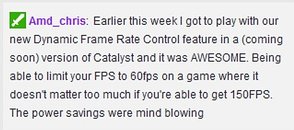Wednesday, December 17th 2014

AMD Working on "Dynamic Frame Rate Control" Feature
AMD is working on a new software feature for its Radeon graphics cards, which it calls "Dynamic Frame Rate Control." Revealed informally to the web, by AMD director of PR Chris Hook, who goes by the handle "AMD_Chris" on various forums, Dynamic Frame Rate Control, or DFRC, is a frame-rate limiter, which gives you power savings when you reduce frame-rates. This probably works by reducing clock speeds to achieve the desired frame-rates.
Sounds a lot like V-Sync? Well the way AMD describes it, DFRC is a frame-rate limiter with a slider. Whereas V-Sync makes the GPU spit out frame-rates to match the monitor's refresh-rate. When a game runs, say, 100 FPS, and you enable V-Sync to bring that down to 60 FPS, your GPU is still running at 3D-performance clocks, unless the 3D load is way too low, and the driver decides to change the power state altogether. DFRC probably achieves lower frame-rates by underclocking the GPU, and increasing the clocks, whenever the scene gets more demanding, and the output FPS drops below the target. Hook describes the energy savings with DFRC as "mind blowing." This peaks our curiosity.
Source:
3DCenter.org
Sounds a lot like V-Sync? Well the way AMD describes it, DFRC is a frame-rate limiter with a slider. Whereas V-Sync makes the GPU spit out frame-rates to match the monitor's refresh-rate. When a game runs, say, 100 FPS, and you enable V-Sync to bring that down to 60 FPS, your GPU is still running at 3D-performance clocks, unless the 3D load is way too low, and the driver decides to change the power state altogether. DFRC probably achieves lower frame-rates by underclocking the GPU, and increasing the clocks, whenever the scene gets more demanding, and the output FPS drops below the target. Hook describes the energy savings with DFRC as "mind blowing." This peaks our curiosity.

67 Comments on AMD Working on "Dynamic Frame Rate Control" Feature
Much was talked about Mantle but it's yet to deliver: perhaps this will be different? Dunno.
As for DFRC, sounds interesting. I've yet to upgrade from a 60Hz monitor so this could be big for me. I'm already seeing <350W figures while gaming but if this can slash 10% or so it would be a welcomed improvement. I guess it'll launch along the Hawaii refresh?
Being serious, I like AMD but I don't see the utility for this software.
There are plenty of reviews of the Nvidia implementation (I recommend this one for being reasonably comprehensive) if you want to learn more about how it works and what power reduction can be expected.
I would think that's what the slider is there for. Adaptive Sync monitors will still be limited to 60hz - 120hz & 144hz like all other monitors. Having a driver cap in Catalyst wouldn't call for a 3rd party app to limit frame rate and not exhibit the increase lag experience under that scenario.
However, dropping frames down is a gr at idea but I struggle to see any relevance in AAA games at QHD or UHD resolutions where fps can already be close to the bone.
This level of tech only works if your gfx solution is delivering higher frame rates than are required for a smooth performance.
I wonder if the PR slides use a 295x2 on a 1080p screen.
All being said, it's good they're looking at means of dialling back the power use.
Looks like an educated guess to me.
I always try to play with vsync on and if you look at the power consumption with it on vs off on many titles there is a substantial difference. If this allows clock rate adjustment to achieve the synced rate it should be even better - if it even went so far as to put "extra" cards into zero-core (power them off) when running a title that doesn't need them to get xx(x)fps that would be excellent too.
Another possible side-benefit would be if the changed clock speed also reduced/eliminated the dreaded coil whine that many cards unfortunately suffer, especially with water blocks on them.
A big thumbs up from me if this does what's claimed, the sooner we get it the better, maybe with Omega release 2? (I can dream).
In the case of my cards, even with a soft heat pad material/glue around the caps/chokes and between them and the liquid block, they still whine a bit with the water blocks on - I'm very sensitive to it though, others say they can't hear it and think my machine is silent.
If those deliver at least this performance or approximately, then it's fine. Hope to see them soonish, Q1 2015, anyone? :happy: :p :D
The irony is, I would buy a 295X2 in a flash if I didn't care about the increase power use (or the possibility of coil whine). Hell, I'd splash out on the Ares version, I think it's tech porn in extreme. I just don't like where AMD are coming from just now, it all seems words, words, words with little actual substance.
And though it's not required I'll do it for balance- Nvidia pissed their 780ti buyers off by not releasing a 6Gb version (oh, look another lamo Titan variant instead). They gave the spent underdog 780 6Gb but said "fuck you" to the 780ti crowd - wait your Honour, this is relevant to my rebuttal of NV.
It seems Nvidia squeeze the market because they can and AMD seem to crank up their PR half wits every couple of weeks.
So close to buying a PS4. Hell, and a XBONE - hell both come to the cost of my 780ti classified.
Screw Red and Green.
#seewhatididthere
Q3?
DX9, crossfire is broken, :laugh:
See what I did there :p
And if you're playing Q3 at 600p, Dr Who wants his Tardis back. :D